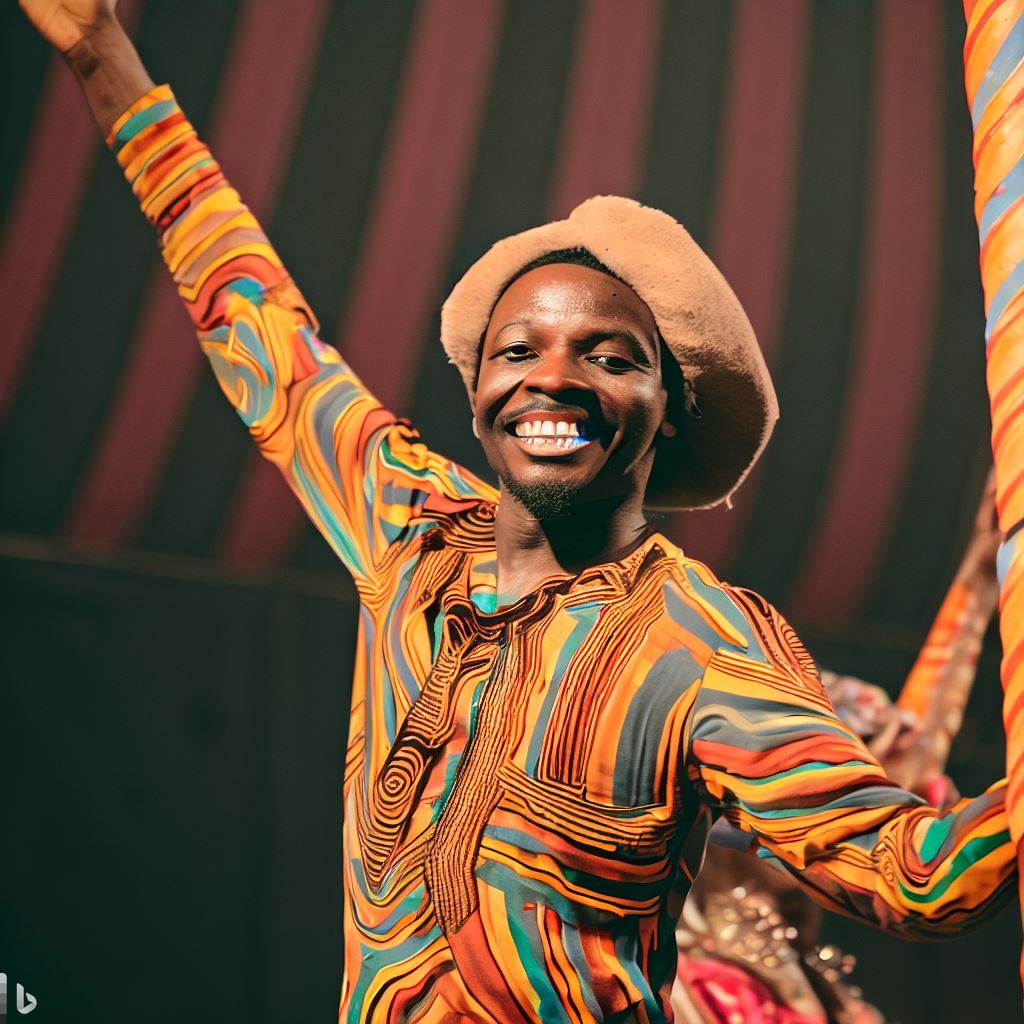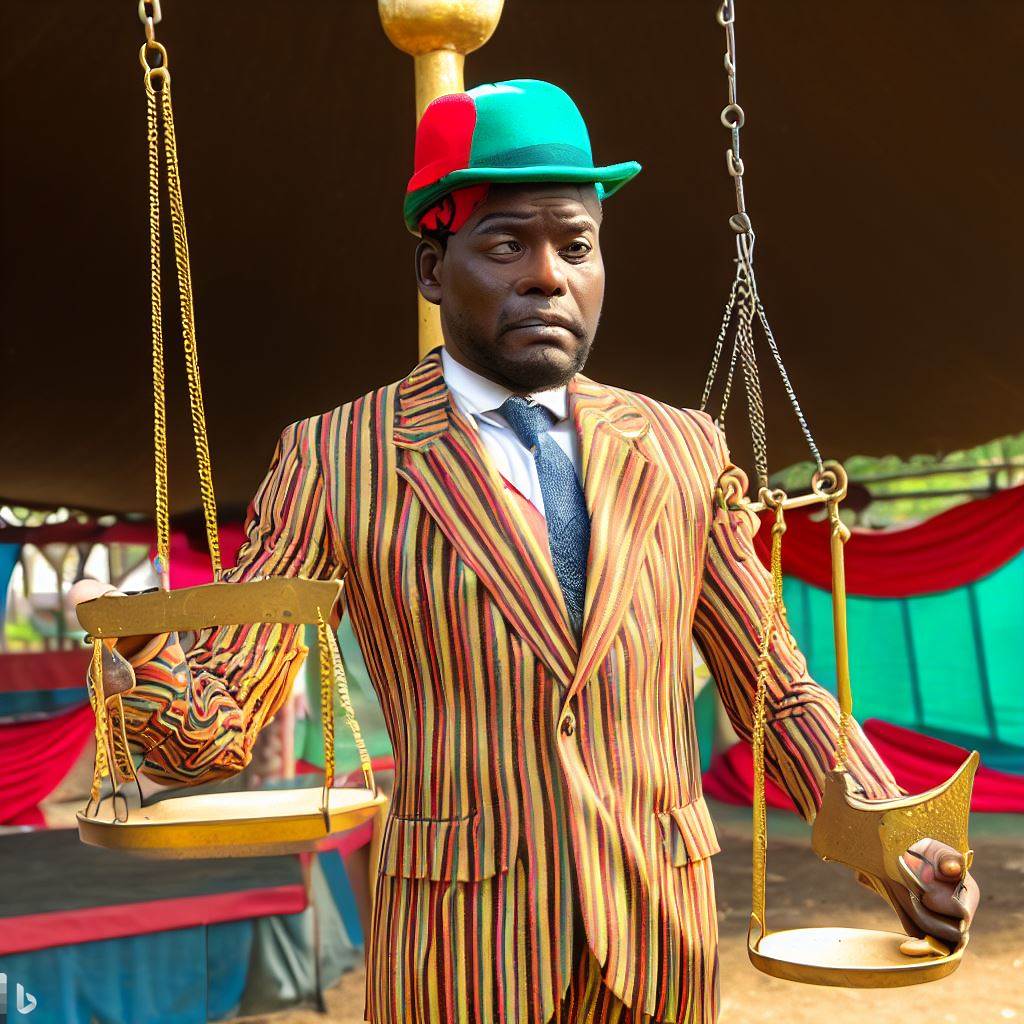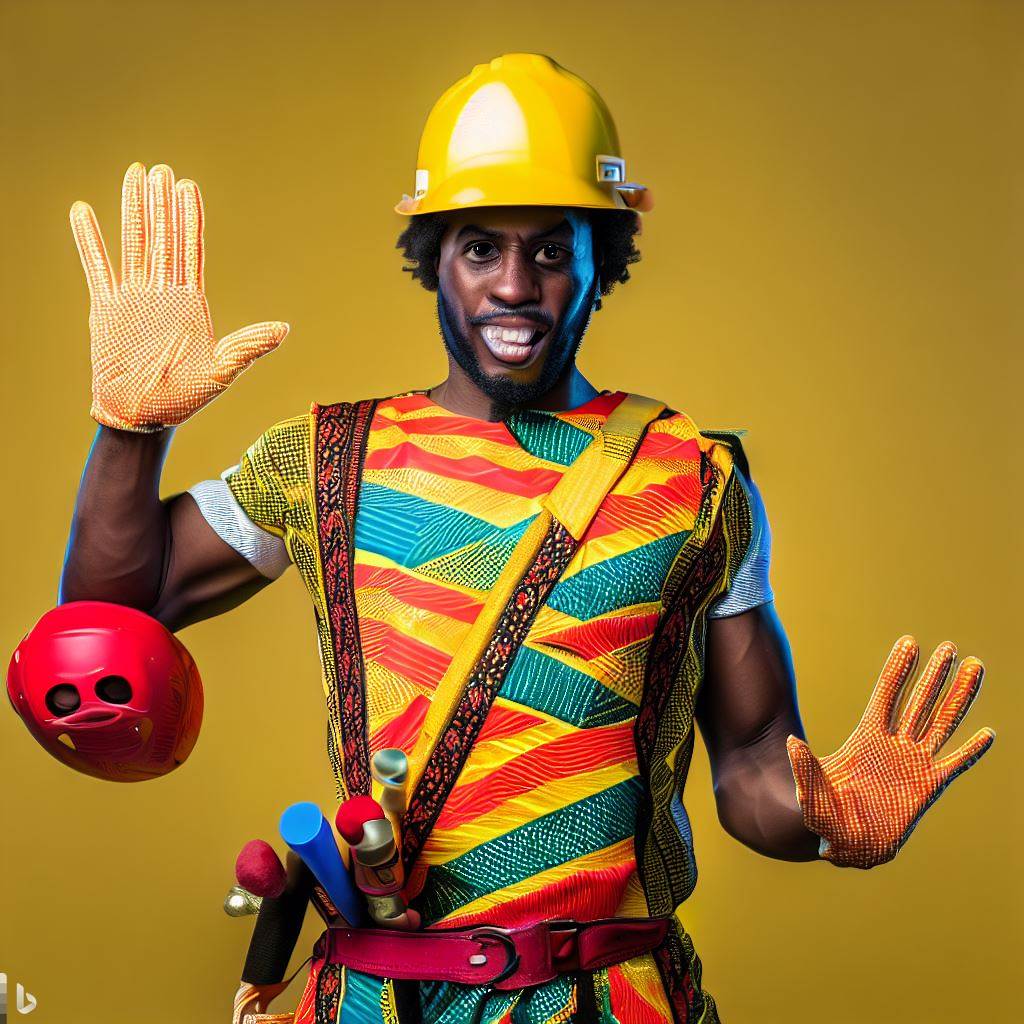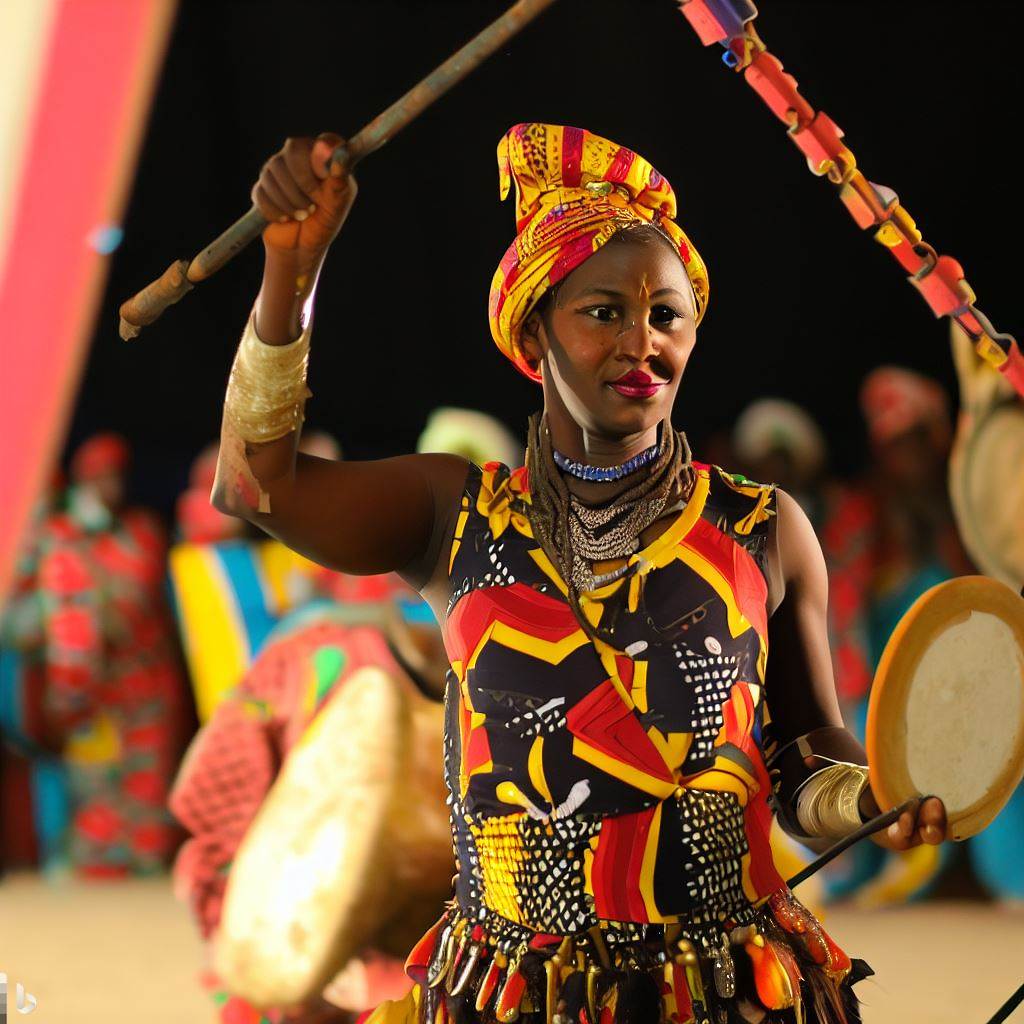Introduction
Circus performance art in Nigeria has a unique and vibrant history worth exploring.
This blog post will discuss Nigeria’s contributions to circus performance art, highlighting its cultural significance, key performers, and impact on the global circus community.
Nigeria’s vibrant culture extends beyond music and literature—its contribution to circus performance art is equally remarkable. In this chapter, we will explore the captivating world of Nigerian circus artists and their unique impact on this global art form.
Thesis Statement
This blog post will delve into Nigeria’s rich history of circus performance art, highlighting the key elements that distinguish Nigerian contributions in this captivating and diverse field:
- Cultural Fusion: Nigerian circus artists infuse their performances with elements of traditional music, dance, and storytelling, creating a mesmerizing fusion of art forms that transcends boundaries.
- Acrobatic Prowess: Nigeria boasts a wealth of acrobatic talents whose awe-inspiring feats push the boundaries of physicality and gravity, leaving audiences breathless.
- Diversity of Acts: From fire-breathers to contortionists, Nigeria’s circus scene showcases an impressive array of acts, each reflecting the nation’s diverse heritage and creativity.
- Social Commentary: Nigerian circus often carries subtle messages of social change and empowerment, using humor and satire to shed light on important issues.
- Global Recognition: Nigerian circus artists have gained recognition on the international stage, elevating the country’s reputation in the global circus community.
- Educational Outreach: Many Nigerian circus troupes engage in educational programs, teaching circus skills to youth and promoting artistic expression as a means of personal development.
- Preservation of Tradition: Through their performances, Nigerian circus artists preserve and celebrate traditional customs and stories, ensuring that cultural heritage remains alive and relevant.
Nigeria’s contribution to circus performance art is a testament to the nation’s creativity, resilience, and dedication to preserving and evolving its rich cultural traditions.
Join us as we embark on a thrilling journey through this captivating world, where the magic of the circus meets the vibrant spirit of Nigeria.
Historical Background of Circus Performance Art
The origins of circus performance art
The origins of circus performance art can be traced back to ancient civilizations.
Circus-like performances can be found in ancient Rome, China, and Egypt.
These performances included acrobatics, juggling, and animal acts.
However, the modern concept of the circus began to take shape in the 18th century.
This was the time when equestrian acts started gaining popularity, especially in Europe.
Performers showcased their skills in riding and performing tricks on horseback.
Over time, circus performances expanded to include a variety of acts and disciplines.
The development and evolution of circus arts globally
The development of circus arts can be seen in the rise of the traveling circus.
In the 19th century, circuses started to tour different cities and countries.
Pioneers in the industry, such as P.T. Barnum and the Ringling Brothers, played crucial roles in the development of the modern circus.
Through their innovative ideas, they introduced new acts and attractions to captivate audiences.
The circus became a form of entertainment that brought together people from all walks of life.
As time went on, the circus continued to evolve with the incorporation of new technologies and techniques.
The emergence of circus in Nigeria
In Nigeria, circus performance art has a unique and vibrant history.
It was during the colonial era that circus performances started gaining popularity.
European settlers brought their circus traditions and introduced them to the Nigerian people.
These early circus shows featured mainly foreign performers and animals.
However, Nigerian artists soon began to embrace the circus as a means of artistic expression.
They adapted and fused traditional Nigerian performing arts with circus skills.
This led to the creation of unique and captivating circus acts that showcased Nigerian culture.
Today, Nigeria has its own circus companies, such as the Kalabari National Circus and the African Circus Arts Foundation.
The origins of circus performance art can be traced back to ancient civilizations, but it was in the 18th century that the modern concept of the circus began to take shape.
Globally, the development and evolution of circus arts can be seen in the rise of the traveling circus and the introduction of new acts and attractions.
In Nigeria, circus performance art emerged during the colonial era and has since grown to incorporate traditional Nigerian performing arts, creating a unique and vibrant circus culture.
Traditional Circus Performance in Nigeria
Introduce the traditional circus performance art forms in Nigeria
- The traditional circus performance art forms in Nigeria are rich and diverse.
- These art forms include acrobatics, fire-eating, juggling, and animal acts.
- They are deeply rooted in Nigerian culture and have been passed down through generations.
The cultural significance and historical context of these traditional performances
- Traditional circus performances hold great cultural significance in Nigeria.
- They are often part of celebrations, festivals, and religious ceremonies.
- These performances reflect the history and traditions of different Nigerian tribes and communities.
- They showcase the resilience, strength, and creativity of the Nigerian people.
The skills and techniques involved in traditional Nigerian circus performances
- Acrobatics: Performers showcase their agility, balance, and strength through impressive stunts and tricks.
- Fire-eating: This daring act requires precision and control to manipulate fire without harm.
- Juggling: Performers master the art of tossing and catching objects, displaying coordination and hand-eye skills.
- Animal acts: Traditional Nigerian circus performances often feature trained animals like monkeys, dogs, and snakes.
- Mask dances: Performers wear intricately designed masks and perform dances that tell cultural stories and legends.
- Musical accompaniment: Traditional Nigerian circus performances are accompanied by vibrant music and drumming.
Overall, traditional circus performances in Nigeria serve as a means of entertainment, cultural preservation, and community bonding.
These performances not only entertain audiences but also provide an opportunity for artists to showcase their skills and preserve their cultural heritage.
The historical context of these performances adds depth and meaning to their significance, allowing viewers to gain a deeper understanding of Nigerian traditions and values.
The skills and techniques involved highlight the talent and dedication of the performers, as they spend years perfecting their craft.
Traditional Nigerian circus performances are truly a unique and captivating form of art that deserves recognition and appreciation.
Read: The Nigerian Hip Hop Scene: Artists to Watch
Contemporary Circus Performance in Nigeria
Transition from Traditional to Contemporary Circus Performance
- Circus performance in Nigeria has evolved over time, transitioning from traditional forms to contemporary styles.
- In the past, circus acts in Nigeria were primarily focused on acrobatics, animal displays, and fire breathing.
- However, with globalization and the influence of Western circus traditions, Nigerian circus performers began incorporating new skills and techniques.
- This transition allowed for the introduction of aerial acts, juggling, clowning, and other contemporary circus elements.
- The shift from traditional to contemporary circus performance opened up new opportunities for Nigerian artists to showcase their talents.
Growth and Development of Contemporary Circus Troupes and Companies
- Over the years, Nigeria has witnessed a significant growth in contemporary circus troupes and companies.
- These groups have not only expanded in number but also in their artistic repertoire and professionalism.
- Cirque Nigeria, for example, is one of the pioneering contemporary circus companies in the country.
- They have been instrumental in raising the profile of circus performance and providing training opportunities for aspiring performers.
- Other troupes like the Lagos Acrobatics School and Wild Fusion Circus have also contributed to the growth of the industry.
Integration of Nigerian Culture and Traditions into Modern Circus Performances
- Contemporary circus performances in Nigeria often feature a strong integration of Nigerian culture and traditions.
- This helps preserve and promote the rich cultural heritage of the country while bringing a unique flavor to the art form.
- Performers incorporate indigenous music, costumes, dance, and storytelling into their acts, creating a captivating blend of tradition and modernity.
- This cultural integration not only adds depth and authenticity to circus performances but also serves as a form of cultural exchange.
- It allows Nigerian circus artists to share their heritage with global audiences, fostering cross-cultural understanding and appreciation.
The contemporary circus performance scene in Nigeria has witnessed a remarkable transformation.
From a traditional focus on acrobatics and animal displays, Nigerian circus performers have embraced contemporary styles and techniques.
This has led to the growth of numerous circus troupes and companies, contributing to the development of the industry.
Moreover, the integration of Nigerian culture and traditions into modern circus performances adds a unique and authentic touch, captivating audiences both locally and internationally.
The future looks promising for circus performance in Nigeria as more artists continue to push boundaries and explore innovative ways to showcase their skills.
Read: Challenges and Rewards of Cinematography in Nigeria
Notable Nigerian Circus Performers
Introduce some of the famous Nigerian circus performers
- One remarkable Nigerian circus performer is Babatunde, renowned for his acrobatic skills and daring stunts.
- Another exceptional artist is Kemi, known for her captivating aerial performances that leave audiences breathless.
- Let’s not forget about Ahmed, a talented fire-eater and contortionist who amazes crowds with his flexibility.
- Lastly, we have Oluchi, an expert juggler with unmatched precision and an incredible sense of showmanship.
Provide brief biographies and achievements of these performers
- Babatunde: With over 15 years of experience, Babatunde has performed in major international circuses and won numerous awards for his gravity-defying acts.
He is recognized for pushing the boundaries of human physical capabilities. - Kemi: Born into a family of circus performers, Kemi has been honing her aerial skills since she was a child.
She has graced prestigious stages worldwide and is applauded for her graceful, mesmerizing performances that showcase strength and agility. - Ahmed: Coming from a disadvantaged background, Ahmed learned fire-eating and contortion as a means of survival.
Today, he has gained recognition for his rare talents and has inspired many aspiring performers, proving that dreams can be achieved against all odds. - Oluchi: Growing up in a circus family, Oluchi developed an extraordinary fondness for juggling.
She has astounded audiences across Africa and Europe with her impeccable coordination, precision, and captivating performances.
Their impact on the Nigerian circus performance art scene and beyond
- These remarkable performers have undeniably shaped and elevated the Nigerian circus performance art scene, attracting worldwide attention.
- Babatunde’s daredevil acts have inspired many Nigerian youths to explore acrobatics and pursue their dreams fearlessly.
- Kemi’s mesmerizing aerial displays have not only captivated audiences but also encouraged greater inclusivity of women in the circus industry.
- Ahmed’s extraordinary journey from adversity to acclaim has shown aspiring performers that talent and determination can overcome any obstacle.
- Oluchi’s unmatched juggling skills have brought prestige to Nigerian circus performance art, encouraging young artists to embrace unique talents.
Beyond Nigeria, these performers have also made their mark globally, adding to the rich tapestry of circus performance art:
- Babatunde’s innovative acts have been showcased in renowned international circuses, earning him admiration from fellow performers and audiences worldwide.
- Kemi’s aerial performances have graced prestigious stages across continents, widening the appreciation for Nigerian circus art on a global scale.
- Ahmed’s story of triumph and resilience has inspired individuals from all walks of life, transcending cultural and geographical boundaries.
- Oluchi’s exceptional juggling skills have gained recognition both in Africa and Europe, showcasing the diversity and talent within the Nigerian circus performance art community.
Nigerian circus performers like Babatunde, Kemi, etc have not only made significant contribution with their unique talents but have also impacted the global circus industry.
Their achievements inspire aspiring performers, break barriers, and elevate the art form, solidifying Nigeria’s place on the international stage of circus performance art.
Read: Artist Management: The Nigerian Perspective

Challenges Faced by Nigerian Circus Performers
Obstacles and Difficulties Faced by Circus Performers in Nigeria
- Limited access to suitable training facilities and equipment.
- Absence of standardized curriculum for professional circus training.
- Lack of recognition and support from the government and public institutions.
- Inadequate funding and financial resources for circus companies and performers.
- Poor infrastructure and limited performance venues.
- Challenges in scheduling and managing performances due to lack of proper venues.
Lack of Infrastructure, Training Opportunities, and Financial Support
- Nigeria lacks specialized circus training schools and dedicated training spaces which restricts skill development.
- There is a scarcity of proper training equipment, such as trapezes, tightropes, and juggling props.
- The absence of a standardized curriculum makes it challenging for performers to receive proper training.
- Circus companies struggle financially due to low ticket sales and a lack of sponsorship opportunities.
- The government does not provide adequate financial support to stimulate the growth of the circus industry.
- Limited access to funding sources, grants, and loans inhibits the development of Nigerian circus companies.
Resilience and Determination of Nigerian Circus Performers
- Despite the challenges, Nigerian circus performers continue to strive for excellence in their craft.
- They have built their own training spaces and makeshift training equipment to overcome resource scarcity.
- Nigerian circus performers constantly seek opportunities to train abroad and learn from international experts.
- Some circus companies in Nigeria have formed collaborations with foreign organizations to access funding and support.
- Through grassroots initiatives, circus performers raise awareness and cultivate public interest in their art form.
Nigerian circus performers face numerous obstacles including limited access to training facilities, lack of financial support, and inadequate infrastructure.
However, their resilience and determination allow them to overcome these challenges and continue to pursue their art form.
With increased recognition and support, the Nigerian circus industry has the potential to flourish and contribute significantly to the international circus performance art scene.
Read: Understanding the Role of Cinematographers in Nollywood
Opportunities and Future Prospects
Growing Recognition and Appreciation of Nigerian Circus Performance Art
- Nigerian circus performance art is gaining recognition and appreciation both locally and internationally.
- The unique blend of traditional Nigerian performance arts with circus skills is captivating audiences worldwide.
- Nigerian circus performers are showcasing their talent in prestigious global circus festivals and events.
- The increasing recognition of Nigerian circus performance art provides opportunities for growth and development within the industry.
- Local communities in Nigeria are also showing a growing interest in watching and participating in circus performances.
Potential for Collaboration and Cultural Exchange with International Circus Communities
- Nigerian circus artists have the potential to collaborate with international circus communities in exchange programs.
- Cultural exchange programs provide opportunities for Nigerian circus performers to learn from and share their skills with artists from other countries.
- Collaboration with international circus communities can lead to the exploration of new techniques and creative approaches to circus performance.
- Exchange programs also contribute to the promotion of cultural diversity and mutual understanding through the art of circus.
Role of Government Support and Investment in the Future Development of Circus Arts in Nigeria
- Government support and investment play a crucial role in the future development of circus arts in Nigeria.
- Adequate funding allows for the establishment of training centers and the provision of resources for aspiring circus performers.
- Government initiatives can promote the inclusion of circus arts in educational curricula, fostering the growth of talent from a young age.
- Supportive policies and regulations can create a favorable environment for the growth of the circus industry, attracting both local and international investors.
- Government-backed cultural exchange programs facilitate international collaborations and enhance the reputation of Nigerian circus performance art.
The opportunities and future prospects for Nigerian circus performance art are promising.
The growing recognition and appreciation of Nigerian circus performance art provides a strong foundation for its development.
Cultural exchange programs and collaborations with international circus communities open doors to learn and share skills.
Government support and investment play a crucial role in nurturing and expanding the circus industry in Nigeria.
With continued support and investment, Nigerian circus performance art has the potential to shine on both local and global stages.
Gain More Insights: Women Cinematographers in Nigeria: Shattering Glass Ceilings
Conclusion
To conclude, Nigeria’s contribution to circus performance art is remarkable and deserves recognition.
Nigerian circus performers have brought unique skills, talent, and cultural richness to the global circus industry.
As we appreciate and support Nigerian circus performers, let us remember that their success is a testament to their dedication and passion, and it is crucial to continue promoting and celebrating their achievements.
Nigeria has made significant contributions to the art of circus performance, infusing it with their vibrant culture and talents.
Nigerian circus performers have displayed exceptional skills and creativity, captivating audiences worldwide.
The fusion of traditional Nigerian dances, music, and acrobatics has added a distinct flavor to circus performances, making them truly unforgettable experiences.
Nigeria’s role in circus performance art should not be underestimated or overlooked but celebrated and given the recognition it deserves.
It is important to acknowledge the significance of Nigeria’s contribution, as it highlights the enormous talent and creativity within the country.
Attending their shows, spreading the word, and providing financial support can ensure their continued success and help create opportunities for more aspiring performers.
By doing so, we play a vital role in building a vibrant and inclusive circus community, where talent knows no boundaries.
Let us embrace the diversity and unique talent Nigeria brings to the world of circus performance art.
Together, we can ensure that Nigerian circus performers receive the recognition, support, and opportunities they deserve.




